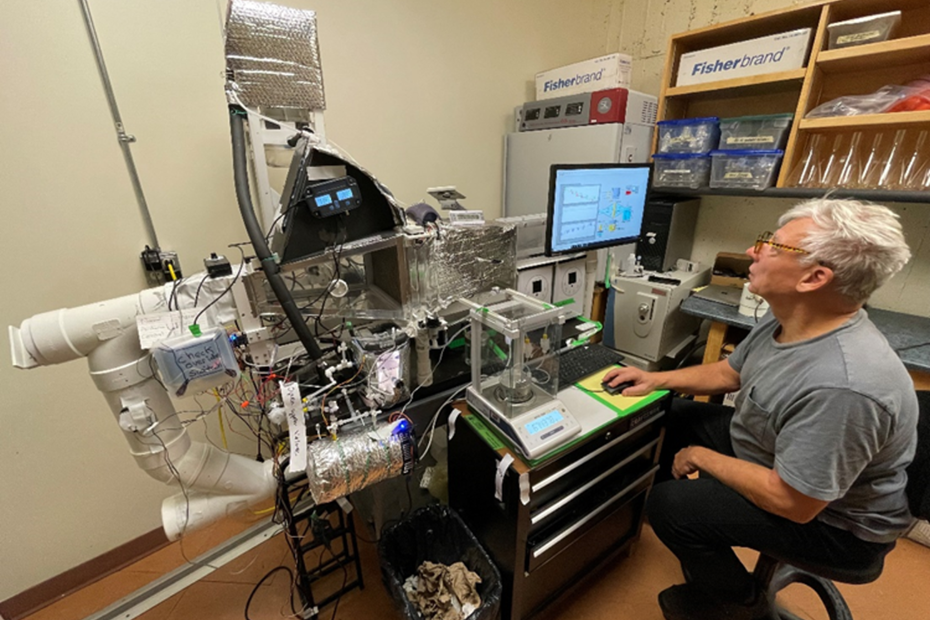By Daniel Liao, Dean, Applied Science, Technology & Trades
Imagine using dry, room temperature air in your dryer instead of energy consuming and expensive heat. That concept and technology was the subject of an applied research project between SLC, industry partner SunBrine, with funding from Mitacs, and QSBRI, a Kingston-based clean technology company.
The project which ran from June to November in 2022 secured funding for a paid internship to examine how SunBrine’s technology can be used in the laundry drying process with the objective of drastically reducing greenhouse gas emissions that are commonly associated with commercial laundry dryers that operate on natural gas rather than electricity.
In the summer of 2022, intern Gary Johnson, a recent grad of SLC’s Biotechnology – Advanced, program, was tasked with building an experimental prototype that simulates the conditions of a laundry dryer through the constant circulation of humid air, complete with an assortment of built-in analytical instruments and data collection interfaces, to determine how much moisture can be removed with SunBrine’s technology.
“The global climate change crisis demands creative departures from technologies based on the convenience afforded by cheap fossil fuels,” Johnson said. “What drew me to intern on this project is the prospect of working towards a solution to drastically reduce the carbon footprint of such a common and easily overlooked process – laundry drying.”
Once commissioned, Gary, under the supervision of Steve White, Professor of Chemistry in the Biotechnology – Advanced program, ran a series of trials on the prototype, which made use of several innovative features to measure the concentration of the moisture-wicking brine medium, in this case a concentrated calcium chloride solution, and report the absolute moisture content of the air stream, all in real time.
Subsequent trials on the heavily instrumented prototype revealed something interesting. While moisture from the air stream was certainly being removed as it came into contact with the brine, the rate of the removal was too subtle for timely drying of wet laundry. Furthermore, much of the four-month project was dedicated to the construction and commissioning of the prototype, and more time was needed to test various combinations of brine temperatures, concentrations, and other types of contact media to improve the rate of moisture removal. However, QSBRI, who contributed several instruments to this project, feels that there is plenty of potential for this technology to be used in a dehumidification or desiccation application, which quite often is another energy intensive application.
Ben Stinson, Vice President of QSBRI noted, “think of the dehumidifier that many of us have in our basements and the power it needs to run! There are two promising outcomes from this project – the design and construction of a test apparatus with the ability collect data on temperature, humidity, flow rate and brine concentration; and the potential for concentrated brine to be used in a dehumidification process. We are pleased to have been a part of this project.”
“This is the reality of research; sometimes things don’t turn out as hypothesized,” Professor Steve White said. “What this project demonstrated is that, as one door closes, another opens. The whole team has gained incredible knowledge on developing methods, overcoming technical challenges, collecting and analyzing data. Despite the unexpected results, the technology is still capable of improving sustainability across various sectors.”
“I’m appreciative of the St. Lawrence College team’s efforts to demonstrate SunBrine’s technology. It was a pleasure to work with Gary and Steve at the college. While the outcome was not as I anticipated at the outset, the knowledge gained was invaluable to furthering the concept of using brine as a form of energy storage.” said Ian McGregor, President of SunBrine Inc.
With the conclusion of this Mitacs-funded applied research project, Professor White and team is now looking for the next industry research partnership opportunity to utilize “Gary’s Test Rig” in a sustainability project involving dehumidification.
About Mitacs
Mitacs empowers Canadian innovation through effective partnerships that deliver solutions to our most pressing problems. By driving economic growth and productivity, we create meaningful change to improve quality of life for all Canadians.
About SunBrine
SunBrine develops technologies that efficiently recover stored energy for useful applications.
About QSBRI
QSBR Innovations Inc. is a Research & Development firm with a focus on solar thermal energy and heat transfer.
For more information on Applied Research contact research@sl.on.ca
